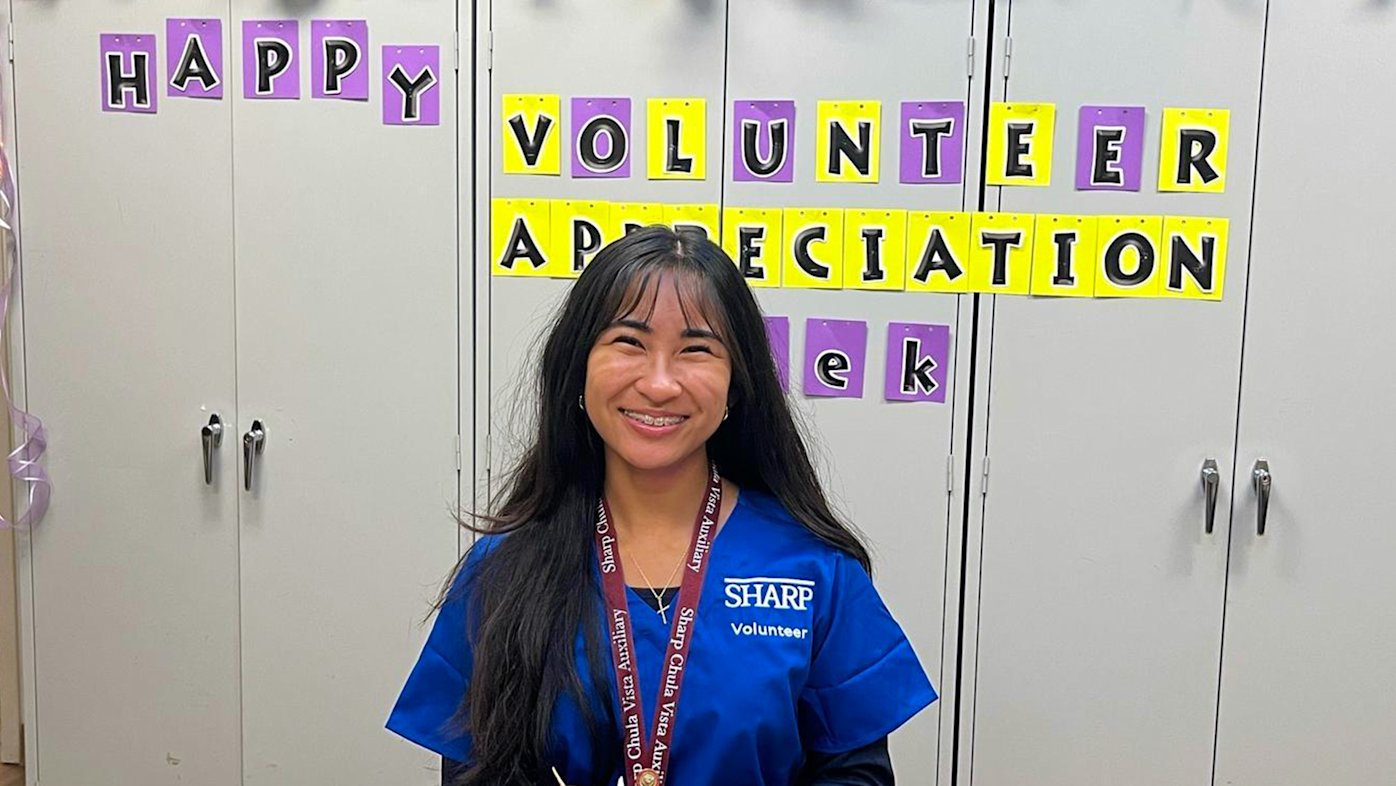
Student volunteer brings joy with wishing cranes
Carefully folded origami cranes carry messages of hope and healing, as one teen volunteer helps brighten patients’ days at Sharp Chula Vista Medical Center.
For 94-year-old Freida Mezoff, a stroll through Legoland California is a stroll down memory lane. The amusement park’s miniature re-creations of iconic landmarks, such as San Francisco’s Golden Gate Bridge and the Las Vegas Strip, conjured up fond memories of when she and her late husband visited these cities in their younger years.
Decades later, Freida is grateful for the memories and for a day at the amusement park with her family, which would not have been possible a few years ago.
In 2019, Freida learned that she had a leaky heart valve — also known as mitral valve regurgitation — that kept her heart from effectively pumping blood throughout her body. The insufficient oxygen caused her to constantly be short of breath.
Despite her age, Freida was living independently and taking care of her daily needs. However, she had been diagnosed with severe mitral valve regurgitation. Given the progression of her condition, Freida was placed on portable oxygen — typically a sign that her condition would eventually lead to worsening health outcomes.
At that point, doctors decided on a watch-and-wait approach. Her advanced age put her at risk for complications associated with any further invasive tests and treatments.
A deep desire to breathe easier, live longer
Then, in July 2021, Freida was admitted to the hospital with severe shortness of breath. During her hospitalization, she met with Dr. Jad Omran, a complex and high-risk interventional cardiologist affiliated with the Burr Heart & Vascular Center at Sharp Grossmont Hospital. He ran several diagnostic tests.
“Freida’s condition had progressed dramatically, and she was admitted to the hospital with congestive heart failure,” recalls Dr. Omran. “During that period, she had no quality of life and she was feeling miserable. However, she wanted to feel better and was wondering if anything could be done at her age.”
Dr. Omran and his team performed a transesophageal echocardiogram with 3D imaging to get a view of what was going on in her heart. The images helped Dr. Omran create precise procedural and treatment plans for Freida, and she was deemed an appropriate candidate for mitral valve repair with the MitraClip system.
“Dr. Omran is a very nice person to talk to,” says Freida. “He is the doctor that puts you right at ease. He told me that I was a reasonable candidate for the procedure and explained to me how it worked.”
The MitraClip procedure provides hope
The mitral valve is located between the upper and lower chambers on the left side of the heart. It consists of two flaps that open and close to help regulate blood flow in one direction between the chambers.
Mitral valve regurgitation occurs when the flaps do not completely shut. When this occurs, blood that would normally flow from the heart to the rest of the body ends up flowing back into the heart.
Without enough oxygen-rich blood reaching other vital organs, a person may feel very tired and short of breath. In severe cases such as Freida’s, it can also lead to heart failure or atrial fibrillation (AFib).
The MitraClip procedure takes approximately 2 to 3 hours, and patients usually go home the following day. Sharp Grossmont Hospital’s Burr Heart & Vascular Center has offered this procedure since 2020.
“I talked it over with the family, but the final thing that convinced me to have the procedure was when Dr. Omran said that it is fairly painless and I am an appropriate candidate,” recalls Freida. “At the end of my conversation with him, he said to trust him. Somehow, that stayed in my mind. I just had the feeling I could trust him, and it was an amazing experience.”
To fix Freida’s heart valve using the MitraClip system, Dr. Omran inserted a thin tube into a vein in the leg and guided it to her heart. He then inserted the MitraClip device — which is about the size of a dime and looks like a clothespin — into the tube leading to the heart.
Once the device was in the heart, he clipped the loose flaps together to help seal the mitral valve more completely. Closing the gap prevented blood from flowing back into Freida’s heart, thereby restoring normal blood flow.
To Legoland and beyond
Joining her family for a day at Legoland a month after her heart valve procedure, Freida was able to play games and walk around on her own without having to use her oxygen tank. And she wasn’t out of breath.
“Before the procedure, when I walked around anywhere, I had to be with someone because I was unsteady,” says Freida. “And I needed my portable oxygen tank with me just in case.”
Aside from amusement park outings, Freida says she gets around with the help of a walker during her daily routine but has reduced her need for portable oxygen. To stay active, she walks 30 minutes a day, twice a week, and is working toward increasing it to three or four times a week. She also does her own grocery shopping, cleans her home, and enjoys simple moments with her great-grandchildren.
“My granddaughter visits at least once a week with my great-granddaughters,” Freida says. “We sometimes will go to the park, and I play ball with them. I am feeling much better now. And as I celebrate turning 95 years old this March, I would like to again express my heartfelt thanks to Dr. Omran, my other doctors and the staff at Sharp Grossmont Hospital.”
To learn more about Sharp Grossmont Hospital’s state-of-the-art cardiovascular care, visit sharp.com/grossmontheart. To learn more about women’s heart health visit sharp.com/womensheart.
Our weekly email brings you the latest health tips, recipes and stories.